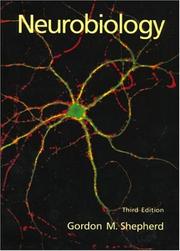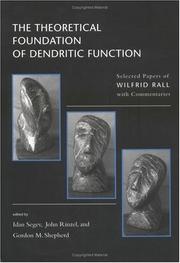| Listing 1 - 6 of 6 |
Sort by
|
Book
ISBN: 0231159102 0231530315 9780231159104 9780231530316 178402550X 1281862827 9786613792143 Year: 2011 Publisher: New York, NY
Abstract | Keywords | Export | Availability | Bookmark
 Loading...
Loading...Choose an application
- Reference Manager
- EndNote
- RefWorks (Direct export to RefWorks)
Leading neuroscientist Gordon M. Shepherd embarks on a paradigm-shifting trip through the "human brain flavor system," laying the foundations for a new scientific field: neurogastronomy. Challenging the belief that the sense of smell diminished during human evolution, Shepherd argues that this sense, which constitutes the main component of flavor, is far more powerful and essential than previously believed.Shepherd begins Neurogastronomy with the mechanics of smell, particularly the way it stimulates the nose from the back of the mouth. As we eat, the brain conceptualizes smells as spatial patterns, and from these and the other senses it constructs the perception of flavor. Shepherd then considers the impact of the flavor system on contemporary social, behavioral, and medical issues. He analyzes flavor's engagement with the brain regions that control emotion, food preferences, and cravings, and he even devotes a section to food's role in drug addiction and, building on Marcel Proust's iconic tale of the madeleine, its ability to evoke deep memories. Shepherd connects his research to trends in nutrition, dieting, and obesity, especially the challenges that many face in eating healthily. He concludes with human perceptions of smell and flavor and their relationship to the neural basis of consciousness. Everyone from casual diners and ardent foodies to wine critics, chefs, scholars, and researchers will delight in Shepherd's fascinating, scientific-gastronomic adventures.
Brain --- Nose --- Olfactory Perception --- Smell --- Taste Perception --- Taste --- Physiology. --- physiology. --- Physiological aspects. --- Taste. --- Chemical senses. --- Chemoreception --- Senses and sensation --- Chemoreceptors --- Gustation --- Tasting (Physiology) --- Chemical senses --- Drinking behavior --- Tongue --- Food preferences
Book
ISBN: 9780231542876 0231542879 9780231177009 0231177003 9780231177009 Year: 2016 Publisher: New York, NY
Abstract | Keywords | Export | Availability | Bookmark
 Loading...
Loading...Choose an application
- Reference Manager
- EndNote
- RefWorks (Direct export to RefWorks)
In his new book, Gordon M. Shepherd expands on the startling discovery that the brain creates the taste of wine. This approach to understanding wine's sensory experience draws on findings in neuroscience, biomechanics, human physiology, and traditional enology. Shepherd shows, just as he did in Neurogastronomy: How the Brain Creates Flavor and Why It Matters, that creating the taste of wine engages more of the brain than does any other human behavior. He clearly illustrates the scientific underpinnings of this process, along the way enhancing our enjoyment of wine.Neuroenology is the first book on wine tasting by a neuroscientist. It begins with the movements of wine through the mouth and then consults recent research to explain the function of retronasal smell and its extraordinary power in creating wine taste. Shepherd comprehensively explains how the specific sensory pathways in the cerebral cortex create the memory of wine and how language is used to identify and imprint wine characteristics. Intended for a broad audience of readers-from amateur wine drinkers to sommeliers, from casual foodies to seasoned chefs-Neuroenology shows how the emotion of pleasure is the final judge of the wine experience. It includes practical tips for a scientifically informed wine tasting and closes with a delightful account of Shepherd's experience tasting classic Bordeaux vintages with French winemaker Jean-Claude Berrouet of the Chateau Petrus and Dominus Estate.
Wine tasting. --- Food --- Food tasting --- Organoleptic analysis of food --- Taste testing of food --- Flavor --- Sensory evaluation --- Taste testing of wine --- Wine and wine making --- Wine --- Sensory evaluation. --- Taste testing --- Analysis --- Odor --- Testing --- Gaging and testing --- Flavor and odor --- Wine tasting

ISBN: 0195088433 9780195088434 Year: 1994 Publisher: Oxford [etc.] : Oxford University Press,
Abstract | Keywords | Export | Availability | Bookmark
 Loading...
Loading...Choose an application
- Reference Manager
- EndNote
- RefWorks (Direct export to RefWorks)
Nervous System Physiological Phenomena --- Membrane Potentials --- Neuronal Plasticity --- Behavior --- Neurobiology --- Molecular neurobiology --- physiology --- Behavior - physiology
Book
ISBN: 9780231159111 Year: 2013 Publisher: New York : Columbia University Press,
Abstract | Keywords | Export | Availability | Bookmark
 Loading...
Loading...Choose an application
- Reference Manager
- EndNote
- RefWorks (Direct export to RefWorks)
Leading neuroscientist Gordon M. Shepherd embarks on a paradigm-shifting trip through the "human brain flavor system," laying the foundations for a new scientific field: neurogastronomy. Challenging the belief that the sense of smell diminished during human evolution, Shepherd argues that this sense, which constitutes the main component of flavor, is far more powerful and essential than previously believed. Shepherd begins neurogastronomy with the mechanics of smell, particularly the way it stimulates the nose from the back of the mouth. As we eat, the brain conceptualizes smells as spatial patterns, and from these and the other senses it constructs the perception of flavor. Shepherd then considers the impact of the flavor system on contemporary social, behavioral, and medical issues. He analyzes flavor's engagement with the brain regions that control emotion, food preferences, and cravings, and he even devotes a section to food's role in drug addiction and, building on Marcel Proust's iconic tale of the madeleine, its ability to evoke deep memories. Shepherd connects his research to trends in nutrition, dieting, and obesity, especially the challenges that many face in eating healthily. He concludes with human perceptions of smell and flavor and their relationship to the neural basis of consciousness. Everyone from casual diners and ardent foodies to wine critics, chefs, scholars, and researchers will delight in Shepherd's fascinating, scientific-gastronomic adventures.

ISBN: 0262515466 0585342571 0262193566 0262283379 9780262283373 9780262193566 Year: 1994 Publisher: Cambridge : MIT Press,
Abstract | Keywords | Export | Availability | Bookmark
 Loading...
Loading...Choose an application
- Reference Manager
- EndNote
- RefWorks (Direct export to RefWorks)
This collection of fifteen previously published papers, some of them not widely available, have been carefully chosen and annotated by Rall's colleagues and other leading neuroscientists. Wilfrid Rall was a pioneer in establishing the integrative functions of neuronal dendrites that have provided a foundation for neurobiology in general and computational neuroscience in particular. This collection of fifteen previously published papers, some of them not widely available, have been carefully chosen and annotated by Rall's colleagues and other leading neuroscientists. It brings together Rall's work over more than forty years, including his first papers extending cable theory to complex dendritic trees, his ground-breaking paper introducing compartmental analysis to computational neuroscience, and his studies of synaptic integration in motoneurons, dendrodendritic interactions, plasticity of dendritic spines, and active dendritic properties. Today it is well known that the brain's synaptic information is processed mostly in the dendrites where many of the plastic changes underlying learning and memory take place. It is particularly timely to look again at the work of a major creator of the field, to appreciate where things started and where they have led, and to correct any misinterpretations of Rall's work. The editors' introduction highlights the major insights that were gained from Rall's studies as well as from those of his collaborators and followers. It asks the questions that Rall proposed during his scientific career and briefly summarizes the answers.
Dendrites --- Dendrites. --- Models, Theoretical. --- Models, Theoretical --- Neurons --- Cell Surface Extensions --- Investigative Techniques --- Analytical, Diagnostic and Therapeutic Techniques and Equipment --- Nervous System --- Cells --- Cellular Structures --- Anatomy --- Neuroscience --- Human Anatomy & Physiology --- Health & Biological Sciences --- Anatomies --- Cell Components --- Cell Component --- Cellular Structure --- Component, Cell --- Components, Cell --- Structure, Cellular --- Structures, Cellular --- Cell --- Cell Biology --- Nervous Systems --- System, Nervous --- Systems, Nervous --- Investigative Technics --- Investigative Technic --- Investigative Technique --- Technic, Investigative --- Technics, Investigative --- Technique, Investigative --- Techniques, Investigative --- Cell Surface Projections --- Cell Surface Protrusions --- Cellular Protrusions --- Cell Membrane Extensions --- Cell Membrane Projections --- Cell Membrane Protrusions --- Cell Membrane Extension --- Cell Membrane Projection --- Cell Membrane Protrusion --- Cell Surface Extension --- Cell Surface Projection --- Cell Surface Protrusion --- Cellular Protrusion --- Extension, Cell Membrane --- Extension, Cell Surface --- Extensions, Cell Membrane --- Extensions, Cell Surface --- Membrane Extension, Cell --- Membrane Extensions, Cell --- Membrane Projection, Cell --- Membrane Projections, Cell --- Membrane Protrusion, Cell --- Membrane Protrusions, Cell --- Projection, Cell Membrane --- Projection, Cell Surface --- Projections, Cell Membrane --- Projections, Cell Surface --- Protrusion, Cell Membrane --- Protrusion, Cell Surface --- Protrusion, Cellular --- Protrusions, Cell Membrane --- Protrusions, Cell Surface --- Protrusions, Cellular --- Surface Extension, Cell --- Surface Extensions, Cell --- Surface Projection, Cell --- Surface Projections, Cell --- Surface Protrusion, Cell --- Surface Protrusions, Cell --- Nerve Cells --- Cell, Nerve --- Cells, Nerve --- Nerve Cell --- Neuron --- Experimental Model --- Experimental Models --- Mathematical Model --- Model, Experimental --- Models (Theoretical) --- Models, Experimental --- Models, Theoretic --- Theoretical Study --- Mathematical Models --- Model (Theoretical) --- Model, Mathematical --- Model, Theoretical --- Models, Mathematical --- Studies, Theoretical --- Study, Theoretical --- Theoretical Model --- Theoretical Models --- Theoretical Studies --- Computer Simulation --- Systems Theory --- Dendrite --- Mathematical models. --- Mathematical models --- NEUROSCIENCE/General --- Neurology and clinical neurophysiology
Book
ISBN: 9782889193899 Year: 2015 Publisher: Frontiers Media SA
Abstract | Keywords | Export | Availability | Bookmark
 Loading...
Loading...Choose an application
- Reference Manager
- EndNote
- RefWorks (Direct export to RefWorks)
How does the motor cortex enable mammals to generate accurate, complex, and purposeful movements? A cubic milimeter of motor cortex contains roughly ̃10̂5 cells, an amazing ̃4 Km of axons and ̃0.4 Km of dendrites, somehow wired together with ̃10̂9 synapses. Corticospinal neurons (a.k.a. Betz cells, upper motor neurons) are a key cell type, monosynaptically conveying the output of the cortical circuit to the spinal cord circuits and lower motor neurons. But corticospinal neurons are greatly outnumbered by all the other kinds of neurons in motor cortex, which presumably also contribute crucially to the computational operations carried out for planning, executing, and guiding actions. Determining the wiring patterns, the dynamics of signalling, and how these relate to movement at the level of specific excitatory and inhibitory cell types is critically important for a mechanistic understanding of the input-output organization of motor cortex. While there is a predictive microcircuit hypothesis that relates motor learning to the operation of the cerebellar cortex, we lack such a microcircuit understanding in motor cortex and we consider microcircuits as a central research topic in the field. This Research Topic covers any issues relating to the microcircuit-level analysis of motor cortex. Contributions are welcomed from neuroscientists at all levels of investigation, from in vivo physiology and imaging in humans and monkeys, to rodent models, in vitro anatomy, electrophysiology, electroanatomy, cellular imaging, molecular biology, disease models, computational modelling, and more.
Neuroscience --- Human Anatomy & Physiology --- Health & Biological Sciences --- Motor Cortex --- intracortical connectivity --- corticospinal neurons --- directional tuning --- motor control
| Listing 1 - 6 of 6 |
Sort by
|

 Search
Search Feedback
Feedback About UniCat
About UniCat  Help
Help News
News